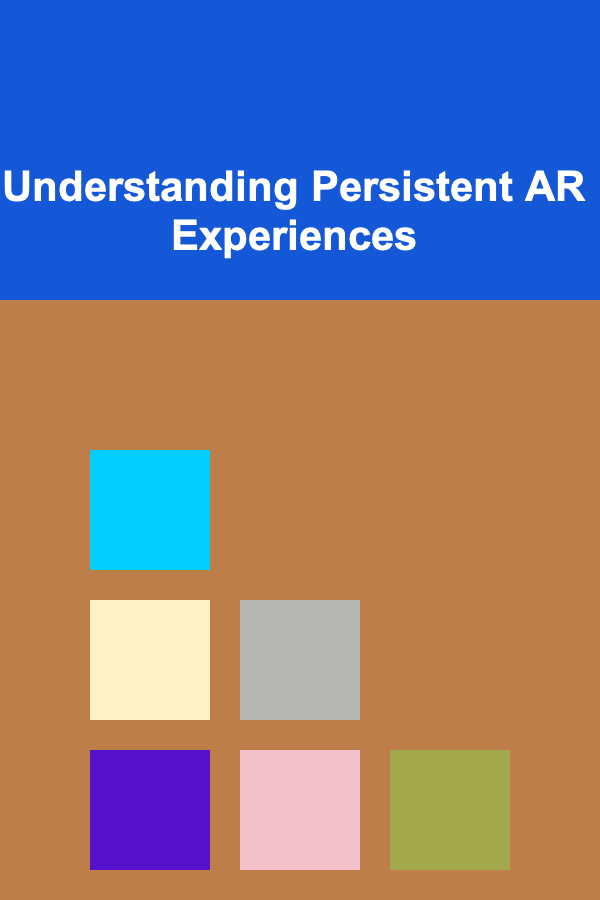
Understanding Persistent AR Experiences
ebook include PDF & Audio bundle (Micro Guide)
$12.99$10.99
Limited Time Offer! Order within the next:

Augmented Reality (AR) is rapidly evolving from a novelty to a powerful tool with applications spanning numerous industries. While early AR experiences were largely ephemeral, triggered and vanishing with the environment, the advent of persistent AR marks a significant leap forward. Persistent AR experiences, as the name suggests, are anchored to the real world and remain in place even when the user moves away and returns. This capability unlocks a new dimension of possibilities, transforming AR from a fleeting overlay into an integral part of our physical surroundings. This article delves into the intricacies of persistent AR, exploring its underlying principles, technological foundations, diverse applications, and the challenges that accompany its widespread adoption.
What is Persistent AR?
At its core, persistent AR refers to augmented reality content that is tied to a specific location or object in the real world and remains accessible over time. Unlike traditional AR experiences that rely solely on marker tracking or GPS location, persistent AR utilizes advanced spatial understanding techniques to map and understand the environment, allowing virtual objects to be placed and remain fixed in place. This creates the illusion that the virtual content is truly part of the physical world, fostering a more immersive and engaging user experience.
Consider a scenario where a user places a virtual note on their office whiteboard using a persistent AR application. Even if they leave the office, turn off their device, and return the next day, the virtual note will still be there, precisely where they left it. This simple example highlights the key distinction between traditional and persistent AR: the ability to maintain the spatial relationship between virtual content and the real world across time and sessions.
The Technological Foundations of Persistence
Several key technologies underpin the creation and delivery of persistent AR experiences. These include:
1. Spatial Mapping and Understanding
Spatial mapping is the process of creating a digital representation of the physical environment. This is typically achieved using a combination of sensors, such as cameras and depth sensors, to capture information about the geometry and appearance of the surroundings. Technologies like Simultaneous Localization and Mapping (SLAM) are crucial for creating these maps.
SLAM algorithms allow AR devices to simultaneously build a map of their environment while also tracking their own position within that map. This is achieved by analyzing visual and inertial data to identify key features and track their movement over time. Different SLAM implementations exist, optimized for various hardware platforms and environmental conditions. Examples include visual SLAM (vSLAM), which relies primarily on camera input, and LiDAR SLAM, which uses laser scanners for more accurate depth information.
Beyond simple mapping, spatial understanding involves analyzing the mapped environment to identify objects, surfaces, and semantic information. This can include recognizing walls, floors, furniture, and even specific objects like desks or chairs. Machine learning models are often used for this task, trained on large datasets of real-world images and 3D models. Spatial understanding enables AR applications to interact more intelligently with the environment, for example, by placing virtual objects on specific surfaces or occluding virtual objects behind real-world obstacles.
2. Anchors and World Tracking
Anchors are virtual points or regions in space that serve as the basis for positioning and orienting virtual objects. They are essential for ensuring that virtual content remains stable and aligned with the real world, even as the user moves around or the device's tracking drifts slightly.
Different types of anchors exist, each with its own strengths and limitations. Plane anchors are used to identify and track flat surfaces, such as floors and tables. Image anchors are used to recognize and track specific images or patterns. Object anchors are used to recognize and track specific 3D objects. Geo anchors are used to anchor virtual content to specific geographic locations, using GPS or other location-based technologies.
World tracking refers to the process of continuously estimating the device's position and orientation in the real world. This is typically achieved by combining data from multiple sensors, including cameras, accelerometers, gyroscopes, and magnetometers. Robust world tracking is crucial for maintaining a stable and immersive AR experience, especially in dynamic environments where the user is moving around frequently.
3. Cloud Storage and Synchronization
For persistent AR experiences to be truly collaborative and accessible across multiple devices, the spatial maps and anchor data need to be stored in the cloud and synchronized across users. This allows multiple users to interact with the same virtual content in the same physical space, even if they are using different devices.
Cloud storage also enables persistence over time, ensuring that the spatial maps and anchor data are preserved even if the device is turned off or the application is closed. This allows users to return to the same AR experience later and pick up where they left off.
Synchronization protocols are essential for ensuring that all users have a consistent view of the AR experience. This requires careful management of data updates and conflict resolution to prevent inconsistencies and ensure that all users are seeing the same virtual content in the same location.
4. Device Hardware and Software Platforms
The availability and capabilities of persistent AR are heavily dependent on the underlying device hardware and software platforms. Modern smartphones and tablets are equipped with powerful processors, cameras, and sensors that enable them to perform the necessary spatial mapping and tracking tasks.
AR development platforms, such as Apple's ARKit and Google's ARCore, provide developers with the tools and APIs they need to create persistent AR experiences. These platforms handle much of the low-level complexity of spatial mapping, tracking, and rendering, allowing developers to focus on creating compelling and engaging content.
Dedicated AR headsets, such as the Microsoft HoloLens and Magic Leap, offer even more advanced capabilities, including stereoscopic displays, hand tracking, and advanced spatial understanding. These headsets are often used for enterprise applications where accuracy and performance are critical.
Applications of Persistent AR
The potential applications of persistent AR are vast and continue to expand as the technology matures. Here are a few key areas where persistent AR is already making a significant impact:
1. Retail and E-commerce
Persistent AR can revolutionize the retail experience by allowing customers to visualize products in their own homes before making a purchase. For example, a customer could use an AR application to place a virtual sofa in their living room and see how it looks with their existing furniture. This can help customers make more informed purchasing decisions and reduce the likelihood of returns.
In-store, persistent AR can be used to enhance the shopping experience by providing customers with interactive product information, personalized recommendations, and wayfinding assistance. For example, a customer could point their smartphone at a shelf of products and see reviews, prices, and nutritional information overlaid on the display.
2. Education and Training
Persistent AR can create immersive and engaging learning experiences by bringing abstract concepts to life. Students can use AR to explore virtual models of the human body, visit ancient historical sites, or conduct virtual science experiments. The ability to interact with these virtual objects in their own physical space can significantly enhance understanding and retention.
In training applications, persistent AR can be used to simulate real-world scenarios, such as operating complex machinery or performing medical procedures. This allows trainees to practice their skills in a safe and controlled environment, without the risk of damaging equipment or harming patients.
3. Navigation and Wayfinding
Persistent AR can provide users with turn-by-turn directions overlaid on the real world, making navigation much more intuitive and efficient. This can be particularly useful in complex environments, such as airports, shopping malls, and university campuses.
Beyond simple navigation, persistent AR can be used to annotate the environment with useful information, such as the location of restrooms, ATMs, and other points of interest. This can help users find what they need quickly and easily, without having to consult a map or ask for directions.
4. Collaboration and Remote Assistance
Persistent AR can enable remote experts to provide real-time assistance to field workers by annotating the environment with instructions and guidance. For example, a technician repairing a complex machine could use AR to show a remote expert the problem and receive step-by-step instructions overlaid on their view of the machine.
Collaborative AR applications can also be used to facilitate design reviews and product demonstrations. Multiple users can view and interact with the same virtual model in the same physical space, allowing them to collaborate more effectively and make more informed decisions.
5. Gaming and Entertainment
Persistent AR can create entirely new gaming experiences by blending the virtual and physical worlds. Players can engage in battles with virtual creatures in their own living rooms, solve puzzles hidden in their environment, or participate in location-based scavenger hunts.
Persistent AR can also be used to enhance existing entertainment experiences, such as concerts and sporting events. For example, attendees could use AR to view virtual stats, replays, and other information overlaid on the field of play.
6. Industrial Applications
In industrial settings, persistent AR finds many uses. It can assist in:
- Maintenance and Repair: Overlaying instructions directly onto equipment needing repair. This reduces errors and speeds up the process.
- Quality Control: Comparing the real product against a digital model for deviations in manufacturing.
- Inventory Management: Overlaying inventory information directly onto shelves, making it easier to locate items and manage stock.
- Plant Design and Optimization: Visualizing proposed changes or new equipment within the existing factory layout before physical implementation, reducing costly errors.
7. Art and Creative Expression
Persistent AR provides artists with a new canvas to express their creativity and engage with audiences in novel ways. Artists can create virtual sculptures that are visible only through AR devices, paint virtual murals on buildings, or create interactive installations that respond to the environment.
Persistent AR can also be used to enhance the experience of visiting museums and art galleries. Museums can use AR to provide visitors with additional information about the artworks on display, create interactive exhibits, or even bring historical artifacts to life.
Challenges and Limitations
Despite its immense potential, persistent AR faces several challenges and limitations that need to be addressed before it can achieve widespread adoption:
1. Accuracy and Reliability
Maintaining accurate and reliable spatial tracking is crucial for a seamless and immersive AR experience. However, current AR systems are still susceptible to errors and drift, especially in challenging environments with poor lighting, repetitive patterns, or dynamic objects.
Improving the accuracy and robustness of spatial tracking requires ongoing research and development in areas such as sensor fusion, computer vision, and machine learning. It also requires careful attention to detail in the design and implementation of AR applications, to minimize the impact of tracking errors on the user experience.
2. Privacy and Security
Persistent AR applications collect and store data about the user's environment, which raises significant privacy and security concerns. Users need to be informed about what data is being collected, how it is being used, and who has access to it.
Robust security measures are needed to protect the stored spatial maps and anchor data from unauthorized access and modification. This includes encryption, access controls, and regular security audits.
Regulations and ethical guidelines are also needed to address the broader societal implications of persistent AR, such as the potential for surveillance, discrimination, and the erosion of privacy.
3. Infrastructure and Bandwidth
Persistent AR applications often require significant bandwidth to stream spatial maps and anchor data in real-time. This can be a challenge in areas with poor network connectivity or limited bandwidth.
Optimizing the bandwidth requirements of persistent AR applications requires careful design and implementation of data compression, caching, and streaming protocols. Edge computing can also be used to process data locally on the device, reducing the amount of data that needs to be transmitted over the network.
The deployment of 5G and other high-bandwidth networks will help to alleviate these challenges and enable more widespread adoption of persistent AR.
4. Power Consumption
Running persistent AR applications can be computationally intensive and consume significant battery power. This can limit the usability of AR devices, especially for extended periods of time.
Optimizing the power consumption of persistent AR applications requires careful design and implementation of algorithms, data structures, and rendering techniques. Hardware acceleration can also be used to offload computationally intensive tasks to dedicated processors, reducing the overall power consumption.
5. Content Creation and Management
Creating compelling and engaging content for persistent AR is a challenging and time-consuming process. It requires specialized skills in 3D modeling, animation, and AR development.
Developing tools and platforms that simplify the process of creating and managing AR content is crucial for enabling widespread adoption. This includes drag-and-drop interfaces, pre-built assets, and cloud-based content management systems.
Furthermore, fostering a vibrant ecosystem of AR content creators and developers is essential for ensuring that there is a diverse range of high-quality AR experiences available to users.
6. Environmental Understanding Limitations
Current AR systems struggle with:
- Dynamic Environments: Constantly changing environments, like crowded streets, pose significant challenges for maintaining accurate persistence.
- Large-Scale Persistence: Creating persistent AR experiences over very large areas (e.g., entire cities) is computationally expensive and requires significant infrastructure.
- Featureless Environments: Areas with minimal visual features (e.g., blank walls, featureless fields) are difficult for AR systems to map and track.
- Occlusion Handling: Properly handling occlusion, where real-world objects block virtual objects, is crucial for realism but can be computationally demanding.
7. Usability and User Experience
Designing intuitive and user-friendly interfaces for persistent AR applications is essential for ensuring that users can easily access and interact with the virtual content. This requires careful consideration of factors such as input methods, visual cues, and feedback mechanisms.
Addressing issues like motion sickness and eye strain, which can be caused by prolonged use of AR devices, is also crucial for improving the overall user experience.
The Future of Persistent AR
Despite the challenges, persistent AR holds tremendous promise for transforming the way we interact with the world around us. As the technology matures and the limitations are addressed, we can expect to see persistent AR become increasingly integrated into our daily lives.
Some of the key trends that will shape the future of persistent AR include:
1. Improved Accuracy and Robustness
Advances in sensor technology, computer vision, and machine learning will lead to more accurate and robust spatial tracking, enabling more seamless and immersive AR experiences.
2. Increased Accessibility
The decreasing cost of AR hardware and the increasing availability of AR development platforms will make persistent AR more accessible to a wider range of users and developers.
3. Integration with other Technologies
Persistent AR will be increasingly integrated with other technologies, such as artificial intelligence, the Internet of Things, and 5G, creating new and innovative applications.
4. Greater Personalization
Persistent AR experiences will become more personalized and adaptive, tailoring the content and interactions to the individual user's needs and preferences.
5. Broader Adoption Across Industries
Persistent AR will be adopted across a wider range of industries, transforming the way we work, learn, play, and interact with the world around us.
Conclusion
Persistent AR represents a significant step forward in the evolution of augmented reality. By anchoring virtual content to the real world and maintaining its position over time, persistent AR unlocks a new realm of possibilities for creating immersive, engaging, and useful experiences. While challenges remain, the potential benefits of persistent AR are undeniable, and its continued development promises to transform numerous industries and reshape our relationship with the physical world.

How to Set Up and Stick to a Debt-Free Living Plan
Read More
How to Soundproof a Shared Wall in a Townhouse or Condo
Read More
How to Use Over-the-Door Organizers for Small Spaces
Read More
How to Incorporate More Fiber into Your Diet
Read More
How to Track Fixed Expenses When Living on a Tight Budget
Read More
How to Plan Content Around User-Generated Content
Read MoreOther Products

How to Set Up and Stick to a Debt-Free Living Plan
Read More
How to Soundproof a Shared Wall in a Townhouse or Condo
Read More
How to Use Over-the-Door Organizers for Small Spaces
Read More
How to Incorporate More Fiber into Your Diet
Read More
How to Track Fixed Expenses When Living on a Tight Budget
Read More